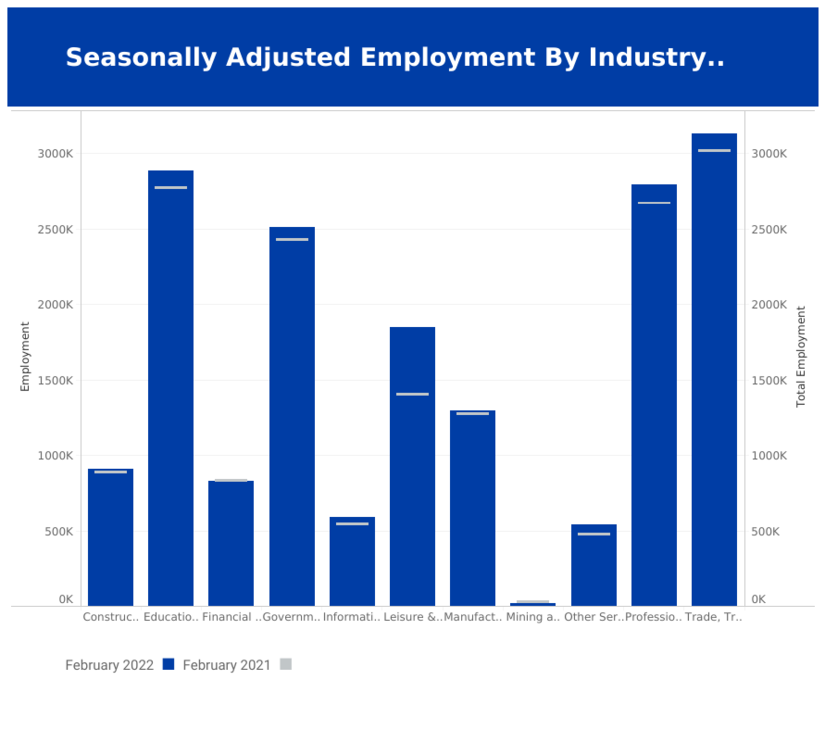
California’s labor market continued to expand at a steady pace in latest numbers, with total nonfarm employment in the state growing by 138,100 positions in February. California’s job additions accounted for just over one-fifth of the nation’s net job gains for the month. January’s gains were also revised up to 60,300 in the latest numbers, a 6,700 increase from the preliminary estimate of 53,600. While California added jobs at a healthy pace in 2021, as of February 2022, the state has still only recovered 87.2% of the jobs that were lost in March and April 2020, and there are currently 353,000 fewer people employed in California compared to pre-pandemic February 2020. Total nonfarm employment in the state has contracted 2.0% since that time compared to a 1.4% drop nationally. With a larger portion of its workforce to be recovered, California’s job growth over the past year has been more robust with payrolls increasing 6.8% from February 2021 to February 2022, well above the nation’s 4.6% increase over the same period. “California’s labor market has had a very encouraging start to the year,” said Taner Osman, Research Manager at the UCR Center for Economic Forecasting & Development and Beacon Economics. “And now that many of the public health mandates restricting activity have been removed, and there is a jobs deficit in the state compared to the nation, we should continue to see strong job growth in the coming months.”
138,100 Jobs Added
California’s labor market continued to expand at a steady pace in the latest numbers, with total nonfarm employment in the state growing by 138,100 positions in February, according to an analysis released jointly with Beacon Economics.
California’s job additions accounted for just over one-fifth of the nation’s net job gains for the month. January’s gains were also revised up to 60,300 in the latest numbers, a 6,700 increase from the preliminary estimate of 53,600.
87.2% Total Jobs Recovered
While California added jobs at a healthy pace in 2021, as of February 2022, the state has still only recovered 87.2% of the jobs that were lost in March and April 2020, and there are currently 353,000 fewer people employed in California compared to pre-pandemic February 2020. Total nonfarm employment in the state has contracted 2.0% since that time compared to a 1.4% drop nationally. With a larger portion of its workforce to be recovered, California’s job growth over the past year has been more robust with payrolls increasing 6.8% from February 2021 to February 2022, well above the nation’s 4.6% increase over the same period.
“California’s labor market has had a very encouraging start to the year,” said Taner Osman, Research Manager at the Center for Economic Forecasting and Beacon Economics. “And now that many of the public health mandates restricting activity have been removed, and there is a jobs deficit in the state compared to the nation, we should continue to see strong job growth in the coming months.”
5.4% Unemployment
The state’s unemployment rate fell to 5.4% in the latest numbers, a 0.3 percentage-point decline from the previous month. California’s unemployment rate remains elevated relative to the 3.8% rate in the United States overall as the state continues to struggle with its labor supply. Since February 2020, the state’s workforce has fallen by 455,000 workers, a 2.3% decline.
_________________________________________________
The Beacon Employment Report | California is a unique analysis of California’s employment numbers and trends. Each month, they link their econometric predictions to data released by the U.S. Bureau of Labor Statistics and the California Employment Development Department to identify important changes in employment across industries and regions. The Beacon Employment Report is also one of the few analyses that uses seasonally adjusted numbers, which are critical to revealing accurate trends and insights within data.
